If a dog doesn’t grow up in a safe and happy environment, it will likely become very antisocial, depressed, and anxious.
Because of this, when the pup does find himself in a place where he can actually relax, he often tries to curl up on himself, hiding away from the world as they are not used to the feeling.
This is why the hooman who is caring for this pup must take things very slow, allowing the dog to relax at his own pace.
Rocky Kanaka, a pet rescue advocate, had the perfect approach with the pup who had an extremely hard time trusting hoomans because of his rough past.
Meet Arthur
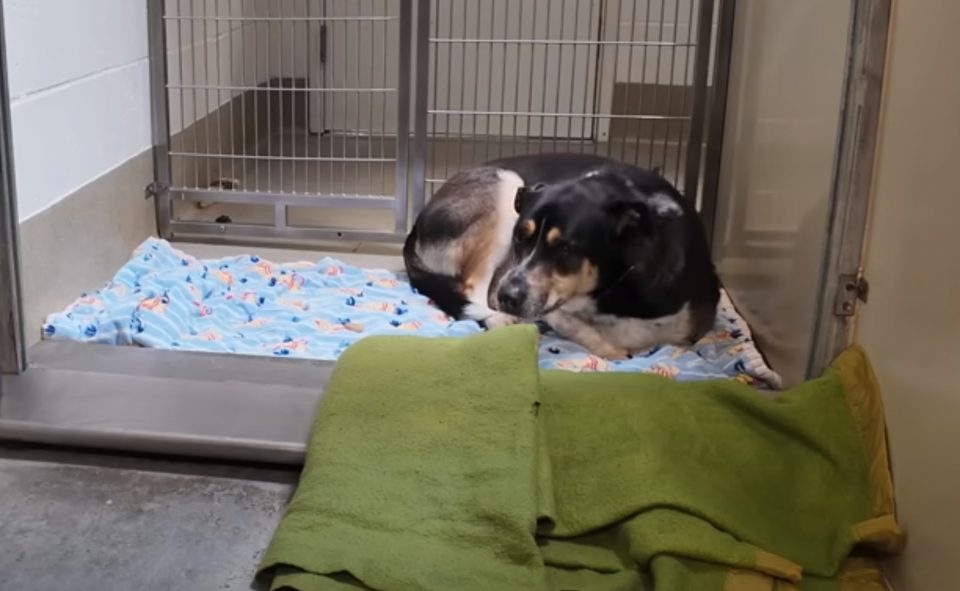
Arthur is an adorable one-and-a-half-year-old Cattle Dog mix who spent his life living as a stray from an unclaimed litter.
He was incredibly grateful to have been adopted shortly after arriving at the shelter. Unfortunately, his happiness did not last too long as his family ended up surrendering him back to the shelter as they were no longer able to take care of him.
This unfortunate event really did take a toll on Arthur.
He was extremely depressed, and anxious, and refused to even look at anyone. However, his behavior was soon about to change when an incredible hooman named Rocky decided to hang out with him for a bit.
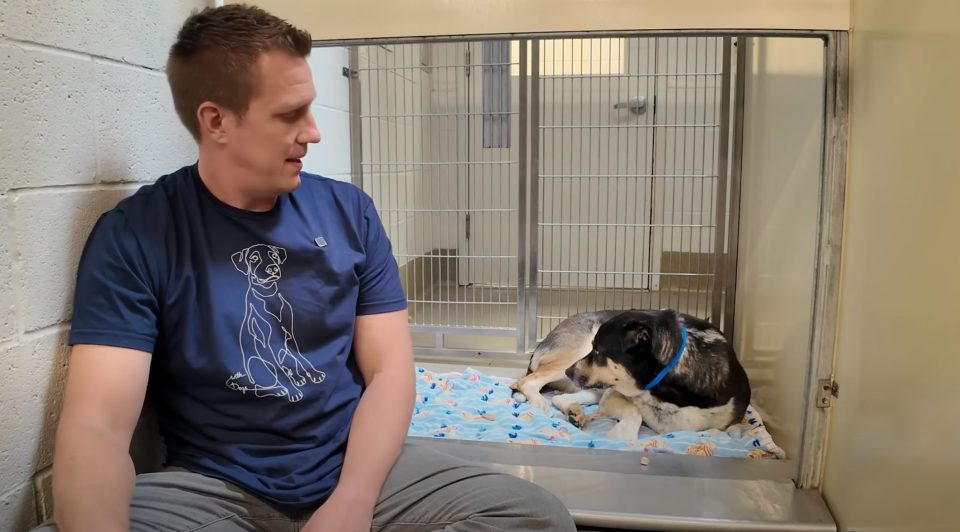
Easy Does It
Since Arthur was kept in the sallyport, an area of the shelter where dogs often enter before they are able to enter the shelter and be examined, it was the perfect opportunity for Rocky to introduce himself.
At first, Rocky decided to sit further away, allowing Arthur to have his own space since the rescuer completely understood that he was very scared because of the unknown environment he found himself in.

As Arthur kept avoiding eye contact, Rocky decided to try and gain his trust by giving him a treat.
Initially, he placed one in front of him, but the pup only smelled it. Then, he placed another one closer to him but, just like the first one, but no luck.
The rescuer then decided to place the treat in his hand and offer it to Arthur, and to his surprise, the pup ate it!
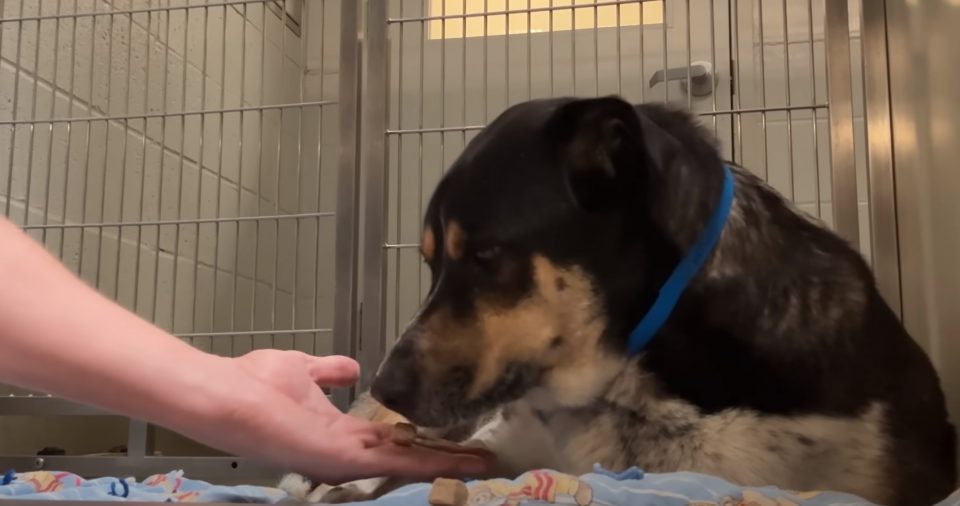
Rocky was overjoyed.
He continued to explain that anxious dogs don’t usually take treats from an opened palm as it increases their anxiety. But, the fact that Arthur took it made Rocky hopeful.
However, even after taking a couple of treats from Rocky, Arthur continued to look away.
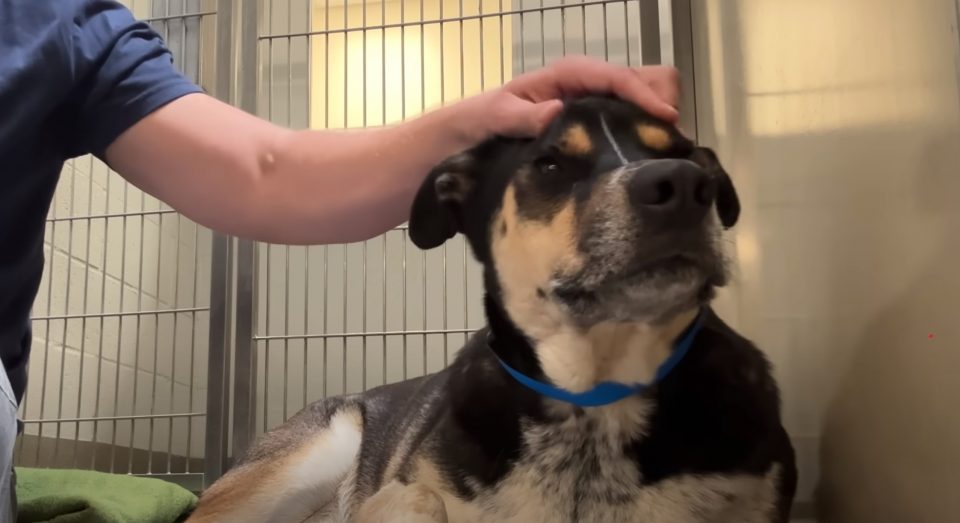
Magic Of Kindness
Finding out that he had been surrendered by his family, somebody who he loved and was loyal to, Rocky’s heart completely broke.
He then decided to shower Arthur with positive affirmations and remind him of what an incredible pup he was.
“I think that you are a good boy and you deserve love and I am sorry that your family left you behind because you did not deserve that. You deserve love, and hugs, and treats… Guess what, today starts the first day of your new life. It’s going to be amazing. I know it’s a little scary right now, but if you trust me, we are going to help you find a home and a family that loves you as much as you love them, okay?” Rocky told Arthur in a YouTube video.
After hearing these incredible words, Arthur started to come out of his shell, even allowing Rocky to give him a good pet.
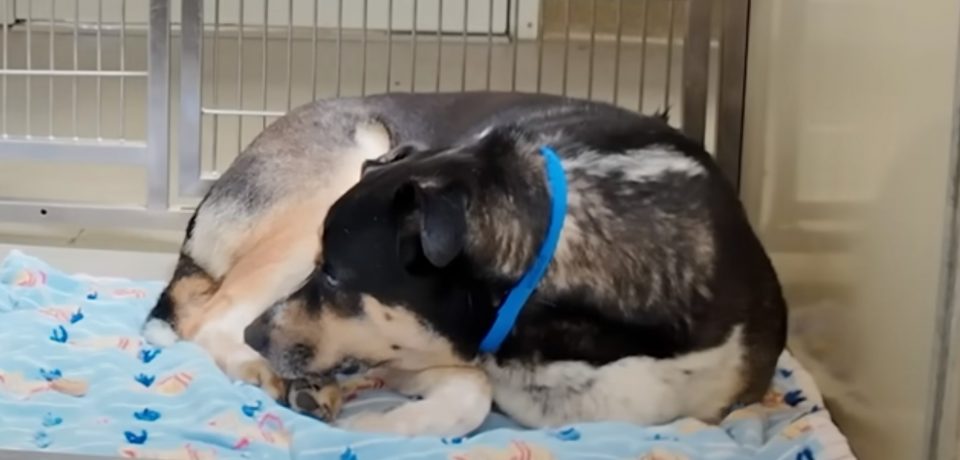
Rocky continued showering Arthur with kind words, and with every single one of them, the pup’s heart was noticeably melting away.
I am sure that with time, Arthur will completely come out of his shell and find a family that can finally provide him with the life he deserved all along.
Rocky, your patience and understanding set the perfect example of just how important it is to take things slow with animals who need some time to figure out just what has happened to them.
You are a hero.
If you’ve ever found yourself buried under a pile of dog fur after just a quick petting session, you’re not alone. The struggle of dealing with your furry friend’s constant shedding can be a real challenge. It’s like your pup is on a mission to leave their mark on every inch of your home, from the carpets to your favorite sweater. But have you ever wondered why your dog sheds so much? It’s not just about making a mess; there are some fascinating reasons behind this furry phenomenon that might surprise you. So, grab your lint roller and get ready to uncover the mysteries of your dog’s shedding habits.
Understanding Dog Shedding
What Influences Shedding in Dogs
Dog shedding is influenced by various factors, such as breed, health, and environment. Different dog breeds shed differently, with some shedding more than others. Factors like diet and overall health can also impact how much your dog sheds. Additionally, environmental factors like temperature and daylight hours can play a role in shedding patterns. Understanding these influences can help you manage your dog’s shedding effectively.
Seasonal vs. Non-Seasonal Shedding
Seasonal shedding is a natural process where dogs lose their old coat to make way for a new one suited to the upcoming season. This shedding typically occurs in the spring and fall. On the other hand, non-seasonal shedding can happen due to various reasons such as stress, diet changes, or underlying health issues. Identifying whether your dog is shedding seasonally or non-seasonally can help you determine the root cause and address it accordingly.
By knowing what influences your dog’s shedding and recognizing the difference between seasonal and non-seasonal shedding, you can take proactive steps to manage and reduce shedding effectively.
Common Breeds That Shed Excessively
Double-Coated Breeds
If you have a dog with a double coat, like a German Shepherd or Husky, you’re likely familiar with their high shedding levels. These breeds have an undercoat for insulation and an outer coat for protection, leading to significant shedding throughout the year. Regular grooming and brushing can help manage the shedding but be prepared for more fur around your home.
Single-Coated Breeds
On the other hand, single-coated breeds such as Poodles or Bichon Frises shed less compared to double-coated breeds. Single-coated dogs may still shed, but the amount is usually minimal and easier to control with regular grooming. If you prefer a dog with minimal shedding, a single-coated breed might be the right choice for you.
Health and Nutrition Factors Affecting Shedding
The Impact of Diet on Shedding
What your furry friend eats can have a big impact on shedding. A balanced diet rich in essential nutrients like Omega-3 fatty acids can help maintain a healthy coat and skin, reducing excessive shedding. Make sure you’re feeding your dog high-quality food tailored to their specific needs to keep them looking and feeling their best.
Signs of Health Issues in Excessive Shedding
If you notice your dog shedding more than usual, it could be a sign of underlying health issues. Keep an eye out for symptoms like bald patches, redness, itching, or changes in their behavior. Excessive shedding could be linked to allergies, hormonal imbalances, or skin infections. If you’re concerned about your dog’s shedding, it’s always best to consult with your veterinarian to rule out any potential health problems.
Grooming Techniques to Manage Shedding
Regular Brushing and Combing
To keep your dog’s shedding under control, regular brushing and combing are essential tasks you should incorporate into your routine. Brushing removes loose fur and prevents matting, especially for breeds with long or double coats like German Shepherds and Huskies. Aim to brush your dog at least a few times a week, focusing on problem areas like the back and belly where shedding is more prominent.
Bathing and the Use of Shed-Control Products
In addition to brushing, bathing your dog with a shedding control shampoo can help manage excessive shedding. Choose a high-quality shampoo designed to reduce shedding and follow a bathing schedule that suits your dog’s breed and coat type. You can also use shed-control products like deshedding tools, wipes, or sprays to minimize loose fur around the house. Remember not to bathe your dog too frequently as it can strip their skin of natural oils, leading to more shedding issues.
Home Remedies and Shedding Prevention
Natural Supplements for Skin and Coat Health
To help reduce excessive shedding in your furry friend, consider adding natural supplements to their diet. Omega-3 fatty acids are essential for maintaining healthy skin and coat. You can easily find supplements like fish oil or flaxseed oil at your local pet store. These supplements can help improve your dog’s skin health, potentially reducing shedding in the process.
Creating an Allergy-Friendly Environment
Allergies can contribute to your dog’s shedding. To minimize allergens in your home, regularly vacuum and clean your dog’s bed and other areas they frequent. Opt for hypoallergenic bedding and toys. Keep your home well-ventilated to reduce dust and dander buildup. Additionally, consider using an air purifier to help maintain a clean and allergy-friendly environment.
Conclusion
So, there you have it – shedding in dogs can be influenced by various factors like breed, health, and environment. Understanding these factors can help you manage your furry friend’s shedding better. Remember to pay attention to your dog’s diet, grooming routine, and overall health to minimize excessive shedding. Keep an eye out for any unusual signs and consult your vet if needed. By incorporating proper grooming techniques, shedding control products, and creating an allergy-friendly environment, you can help reduce the amount of fur your dog leaves around the house. Remember, a little extra care goes a long way in keeping your pup’s shedding in check.
Frequently Asked Questions
What factors influence shedding in dogs?
Shedding in dogs can be influenced by breed, health, and environment factors. Understanding these factors is crucial for managing shedding effectively.
What are some common breeds known for excessive shedding?
Common breeds known for excessive shedding include German Shepherds, Huskies, Poodles, and Bichon Frises. Distinguishing between double-coated and single-coated breeds is essential.
How does diet affect shedding in dogs?
Diet plays a significant role in shedding, with a balanced diet rich in essential nutrients like Omega-3 fatty acids promoting healthy skin and coat. Proper nutrition can help minimize excessive shedding.
What are signs of health issues related to excessive shedding?
Signs of health issues related to excessive shedding may include bald patches, redness, itching, or behavioral changes. Consulting a veterinarian is recommended if such signs are observed.
What grooming techniques can help manage shedding in dogs?
Regular brushing and combing are essential grooming techniques to manage shedding, especially for breeds with long or double coats. Using shedding control shampoo and products can also help minimize loose fur.
How can shedding be controlled at home?
Incorporating natural supplements rich in Omega-3 fatty acids into the dog’s diet can help control shedding. Creating an allergy-friendly environment by reducing allergens and using shedding control products can also be effective.
[no_toc]

Hey there, I’m Janet Brooks, a dog-loving student from California. I’m all about helping pups in need, especially those without homes. Me and my awesome friends work together to give shelter and love to stray dogs. Oh, and I also write blogs about dogs to share helpful info.